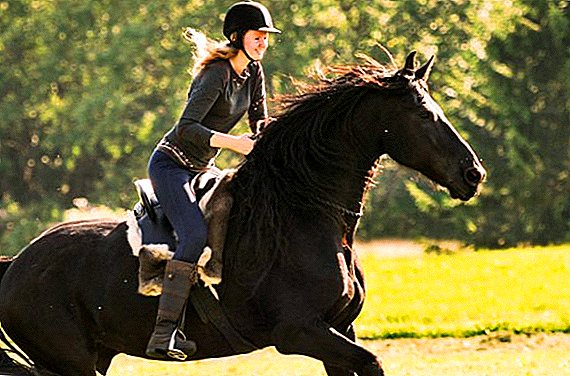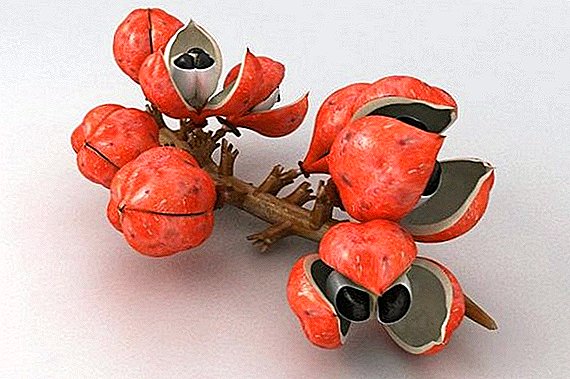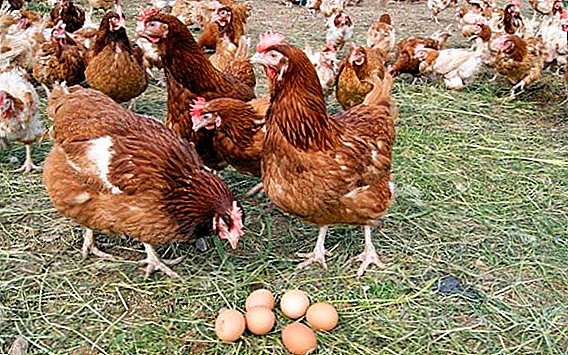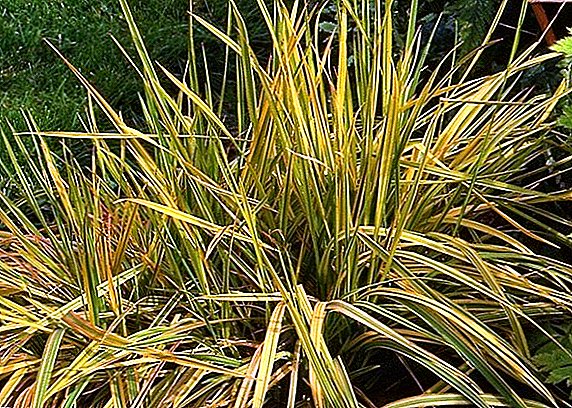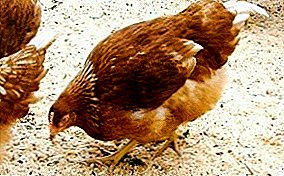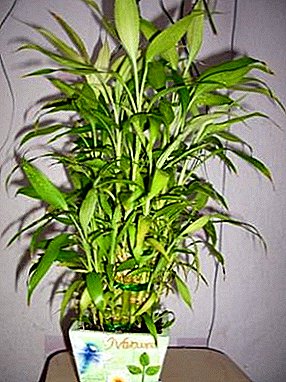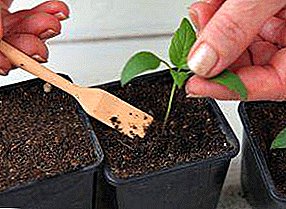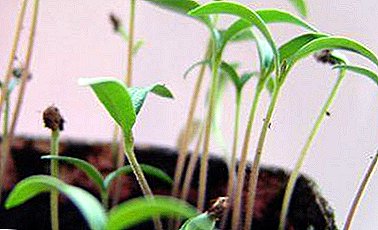
The time of seedling of tomatoes after planting depends on many factors. On average, 5-7 days should pass after sowing, but these periods may vary in one or the other direction.
Growth dynamics in the seedling period affects all subsequent productivity, therefore a similar question for the vegetable grower is extremely important.
From the article we find out what determines the time of emergence of tomatoes, how many days after sowing the shoot should occur and when it is worth worrying. We will also find out whether it is possible to influence the period of germination and for what reasons the growth of tomatoes is delayed.
What determines the time of emergence of tomatoes?
 Impact on growth have:
Impact on growth have:
- Variety and seed condition.
- Landing point:
- Home container for seedlings.
- Greenhouse.
- Open ground.
- Soil preparation.
- External conditions
- Proper care.
- Compliance with sowing techniques.
Seed material
Of great importance is:
- seed variety;
- their age;
- storage conditions;
- quality.
Last year may come up in 3 days, two-year-olds will need about a week., and the same seeds, but stored for about 3 years, will bite longer. Some dry seeds will take 10 to 20 days.
On average, tomato seeds remain viable for 5 years. This term is standard. When purchasing seeds, it should be observed in the event that the expiration date on the package is not specified.
There are also specialized varieties, one of the advantages of which is a shelf life of up to 15 years. In this case, this item must be specified by the manufacturer.
Important! Small seeds need a sufficient amount of light, they should be only slightly sprinkled with a layer of soil.
The soil
The soil before planting should be timely prepared:
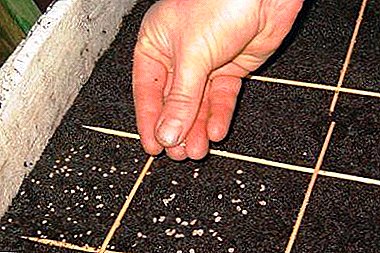 burst out;
burst out;- disinfected;
- warm enough.
Porosity and water permeability are also of great importance for fast and successful germination. The right soil for tomatoes can either be purchased in a ready-made form or you can do it yourself.
As a rule, it is formed from the same shares: peat land, turf, humus. Ash is added in a small amount and 1/5 of the total amount of sand taken from river banks.
If a subsequent picking of plants is planned, fertilize. Before mixing the sand with the soil, it should be disinfected to avoid infection of the soil.
Before planting seeds, the soil is burst and level: for this you can use a wooden plank or, for example, a school ruler. Planted in open ground, seeds take about 10 days to germinate.
Ambient conditions
Best of all, the seeds sprout at a temperature of +25 ° C and no higher than + 30 ° C. If the air temperature is colder, then germination will occur more slowly. When covering with a film, etc., it should be ensured that there is no high humidity, no condensate accumulated, and the seeds received enough oxygen: for this purpose, airing is carried out.
Care
After sowing, it is necessary to cover the wells with a non-woven translucent cover, for example, with a plastic film. At night, the landing should be covered, during the day when the temperature-air regime reaches from +18 ° C and higher, the film should be folded back from the sides.
If seeds are planted in seedling containers, they should also be covered with glass or plastic. At the same time they should be ventilated once or twice a day to avoid excessive moisture and, as a result, moldiness. Sowing tanks should be placed where crops will receive a sufficient amount of heat: for example, in the sun or near radiators.
Council Instead of film or glass, you can use caps, which are easy to make yourself from cut plastic bottles.
In case of drying the soil is moistened using a hand sprayer. Temperature range from +21 to +23 ° C during the day and from +16 to +18 ° C at night.
Two days before planting, the soil is spilled with hot water, having previously dissolved potassium manganese in it (with a solution of potassium permanganate). The day after sowing should be treated with a fungicide.
How many days after sowing should a shoot occur?
When to worry?
 When setting waiting times, it is necessary to take into account all factors affecting growth. Given the above features, depending on them, the emergence of seedlings has to wait from 3 to 20, and often 7-14 days. Low temperatures can slow the process down for 2-3 weeks.
When setting waiting times, it is necessary to take into account all factors affecting growth. Given the above features, depending on them, the emergence of seedlings has to wait from 3 to 20, and often 7-14 days. Low temperatures can slow the process down for 2-3 weeks.
Dry unsprouted seeds, even when transplanting in a greenhouse or in home containers for seedlings, ascend in 5 days or later. It happens that as a result of a rather long wait after disembarking, nothing happens. The reasons for this are different:
- poor quality seed;
- unsuitable or unprepared soil;
- wrong sowing
Is it possible to affect the term?
If the most comfortable conditions are met, the waiting time for germination can be reduced. Properly maintained temperature and humidity, leaving after planting will contribute to faster germination. Also affects the timing:
- the degree of readiness of the planting material for planting;
- preliminary selection of quality material;
- soaking and hardening;
- seed treatment with special solutions;
- use of environmentally friendly and safe growth promoters.
Experienced growers start doing this in February.
What are the reasons for the delay?
- Earlier processing of seeds for their subsequent storage may affect the growth time: after drying, activation of processes slows down.
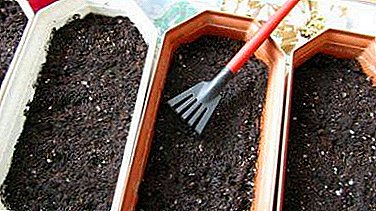 With dry sowing of unsprouted seeds without soaking, germination time increases.
With dry sowing of unsprouted seeds without soaking, germination time increases.- If the landing was made too early, the ground and the earth are not heated enough or frost occurs at night, until the corresponding conditions occur, the seeds will be “asleep” during this time, that is, they will be at rest. In growth they will go only after a sufficient temperature is established for this. The same thing happens with seeds that have been stored at low temperature.
Sprouted seed must be handled very carefully: if the spine was accidentally damaged, it is not worth waiting for the sprout.
- With an incorrectly maintained distance, plants can interfere with each other, with the result that their growth will slow down. The distance between the holes and rows for tomatoes planted in the ground is 2-3 cm and 5-7 cm, respectively. 2-3 seeds are laid in one well. In the containers for germination 0.5-1 cm is enough.
- If the seeding was done at too great depth, the germ will need more time and effort.
Important! The first watering should be carried out before sowing, and not after, in order to avoid possible subsequent sinking of the seed to an excessive depth.
- For seeds, the condition of the soil is important. If it is too wet, it will be poorly supplied with oxygen, in this case there is a threat for the seeds to suffocate: the growth will be slowed down, the plant may even die. In dry soil, it will be difficult for weak seeds to make their way up.
- Also, the soil consistency affects the timing of the shoot: too heavy and dense requires more effort from the plant, too light lead to a weaker development. It is necessary to ensure that there is no excess peat.
- If decontamination has not been carried out, the seeds may be infected. In this case, the sprouts will not grow, and some diseases are able to move to plants in the neighborhood.
- Soil toxicity has a negative effect on the plant. You should not take the soil near water bodies and irrigation fields.
What to do?
If, according to all calculations, seedlings are expected, but they are still not there, you can try to support the development of seeds and pay attention to the following:
- top dressing: in a liquid state, apply to the soil with a sprayer;
- heat balance: for crops in an open ground it is reached by means of shelter by a film;
- light balance: if the light is not enough, you can make the highlight
- humidity level: lack of moisture without fear of damaging the seeds can be eliminated using a sprayer; its excess is eliminated by airing.
It also happens that, despite all the efforts made, sowing has to be done anew. Compliance with the rules of seed storage, pre-selection and seed treatment, planting and subsequent care greatly increases the chances of getting an excellent harvest.


 burst out;
burst out; With dry sowing of unsprouted seeds without soaking, germination time increases.
With dry sowing of unsprouted seeds without soaking, germination time increases.